



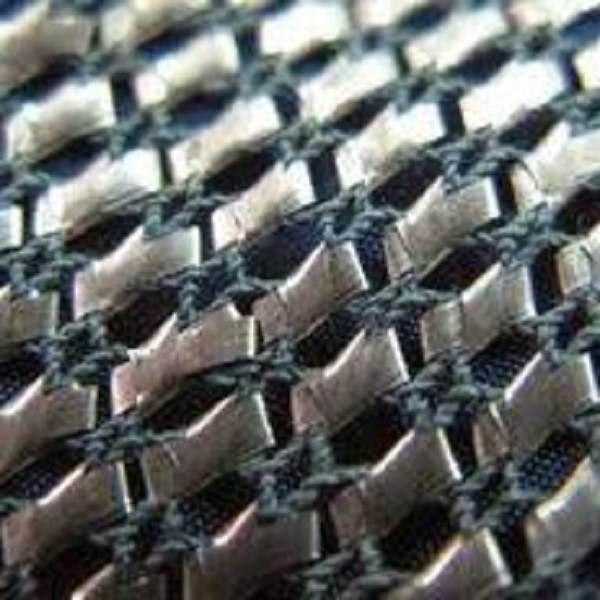
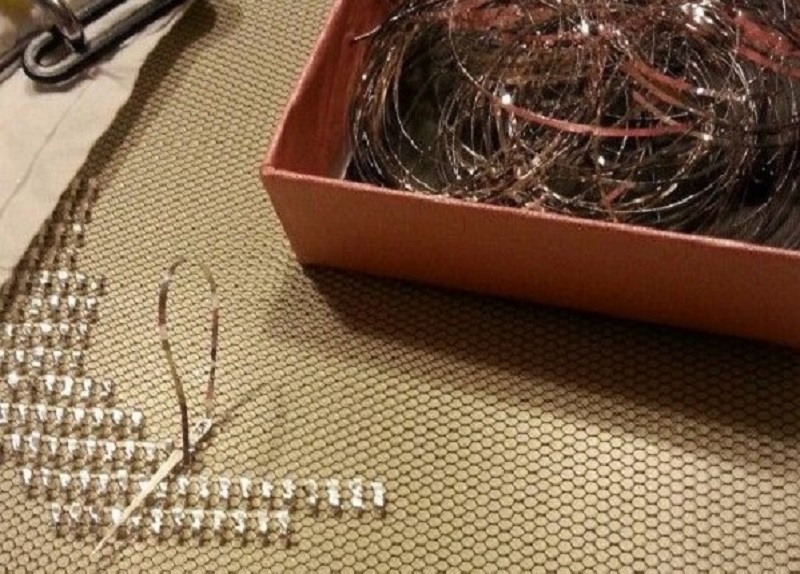 matal straw or khus
Khūṣ: (Arabic: straw, sing. khūṣah), flat silver or metallic flat straw used in embroidery or tallī making. used for embroidery
matal straw or khus
Khūṣ: (Arabic: straw, sing. khūṣah), flat silver or metallic flat straw used in embroidery or tallī making. used for embroideryTūlle_bi_tallī: (French: Tulle – a city in France where fine material for veil was first made; Turkish: tel – wire; Synonym: tariq; talli; badla; khus_dozi
Khus_dozi: (Persian: Khvosh – an Iranian province; dozi – needlework; Synonym: tariq; talli; tulle_bi_talli; badla), series of small metal knots made on a woven net ground as embellishment. The term is commonly used in Iran and parts of the Arabian Peninsula possibly because Khvosh was one of the centres for the craft.
Khus_dozi: (Persian: Khvosh – an Iranian province; dozi – needlework; Synonym: tariq; talli; tulle_bi_talli; badla), series of small metal knots made on a woven net ground as embellishment. The term is commonly used in Iran and parts of the Arabian Peninsula possibly because Khvosh was one of the centres for the craft.
). Indian embroidery technique where small rectangular strips of metal are squeezed shut around some threads of the fabric creating intricate shapes and designs., badla/badlah, fardi, khus_doziKhus_dozi: (Persian: Khvosh – an Iranian province; dozi – needlework; Synonym: tariq; talli; tulle_bi_talli; badla), series of small metal knots made on a woven net ground as embellishment. The term is commonly used in Iran and parts of the Arabian Peninsula possibly because Khvosh was one of the centres for the craft.
). Cotton linen or synthetic mesh hand embellished with flat strips of metal alloys coated with silver or gold squeezed shut around some threads of fabric creating intricate shapes and designs., mnaghad Mnaghad: (Arabic: mnaqad: with coins, synonyms: mnaghadah Mnaghadah: (Arabic: mnaqad: with coins). Since silver was a form of currency, it came to refer to silver adorned garments. The term refers to articles decorated with silver (tallī) straw (khūs) in small coin-like dots. In the Arab Gulf region, the terms (mnaghadah), (mnaghad) (nighdah) and (tallī) are often used interchangeably, with the (qāf) pronounced (gha) colloquially., naghdah Naghdah: (Arabic: mnaqad: with coins, synonyms: mnaghadah Mnaghadah: (Arabic: mnaqad: with coins). Since silver was a form of currency, it came to refer to silver adorned garments. The term refers to articles decorated with silver (tallī) straw (khūs) in small coin-like dots. In the Arab Gulf region, the terms (mnaghadah), (mnaghad) (nighdah) and (tallī) are often used interchangeably, with the (qāf) pronounced (gha) colloquially., mnaghad, mnaghadah Mnaghadah: (Arabic: mnaqad: with coins). Since silver was a form of currency, it came to refer to silver adorned garments. The term refers to articles decorated with silver (tallī) straw (khūs) in small coin-like dots. In the Arab Gulf region, the terms (mnaghadah), (mnaghad) (nighdah) and (tallī) are often used interchangeably, with the (qāf) pronounced (gha) colloquially.). Since silver was a form of currency, it came to refer to silver adorned garments. The term refers to articles decorated with silver (tallī) straw (khūs) in small coin-like dots. The (qāf) is pronounced (gha) colloquially., mnaghadah Mnaghadah: (Arabic: mnaqad: with coins). Since silver was a form of currency, it came to refer to silver adorned garments. The term refers to articles decorated with silver (tallī) straw (khūs) in small coin-like dots. In the Arab Gulf region, the terms (mnaghadah), (mnaghad) (nighdah) and (tallī) are often used interchangeably, with the (qāf) pronounced (gha) colloquially.). Since silver was a form of currency, it came to refer to silver adorned garments. The term refers to articles decorated with silver (tallī) straw (khūs) in small coin-like dots. The (qāf) is pronounced (gha) colloquially., or badlahBādlah: (Hindustani: badal – cloud from Sanskirt: vārdala – water; Synonym: tariq; talli
Tallī: (Turkish: tel – wire, string), Gulf Arab – a woven braided trimming made with metal wire, threads and ribbons often sewn on detachable panels used as embellishments. Other – (Synonym: tulle_bi_talli
Tūlle_bi_tallī: (French: Tulle – a city in France where fine material for veil was first made; Turkish: tel – wire; Synonym: tariq; talli; badla; khus_dozi
Khus_dozi: (Persian: Khvosh – an Iranian province; dozi – needlework; Synonym: tariq; talli; tulle_bi_talli; badla), series of small metal knots made on a woven net ground as embellishment. The term is commonly used in Iran and parts of the Arabian Peninsula possibly because Khvosh was one of the centres for the craft. Khus_dozi: (Persian: Khvosh – an Iranian province; dozi – needlework; Synonym: tariq; talli; tulle_bi_talli; badla), series of small metal knots made on a woven net ground as embellishment. The term is commonly used in Iran and parts of the Arabian Peninsula possibly because Khvosh was one of the centres for the craft. Tūlle_bi_tallī: (French: Tulle – a city in France where fine material for veil was first made; Turkish: tel – wire; Synonym: tariq; talli; badla; khus_dozi
Khus_dozi: (Persian: Khvosh – an Iranian province; dozi – needlework; Synonym: tariq; talli; tulle_bi_talli; badla), series of small metal knots made on a woven net ground as embellishment. The term is commonly used in Iran and parts of the Arabian Peninsula possibly because Khvosh was one of the centres for the craft. Khus_dozi: (Persian: Khvosh – an Iranian province; dozi – needlework; Synonym: tariq; talli; tulle_bi_talli; badla), series of small metal knots made on a woven net ground as embellishment. The term is commonly used in Iran and parts of the Arabian Peninsula possibly because Khvosh was one of the centres for the craft.
Tallī: (Turkish: tel – wire, string), Gulf Arab – a woven braided trimming made with metal wire, threads and ribbons often sewn on detachable panels used as embellishments. Other – (Synonym: tulle_bi_talli
Tūlle_bi_tallī: (French: Tulle – a city in France where fine material for veil was first made; Turkish: tel – wire; Synonym: tariq; talli; badla; khus_dozi
Khus_dozi: (Persian: Khvosh – an Iranian province; dozi – needlework; Synonym: tariq; talli; tulle_bi_talli; badla), series of small metal knots made on a woven net ground as embellishment. The term is commonly used in Iran and parts of the Arabian Peninsula possibly because Khvosh was one of the centres for the craft. Khus_dozi: (Persian: Khvosh – an Iranian province; dozi – needlework; Synonym: tariq; talli; tulle_bi_talli; badla), series of small metal knots made on a woven net ground as embellishment. The term is commonly used in Iran and parts of the Arabian Peninsula possibly because Khvosh was one of the centres for the craft.
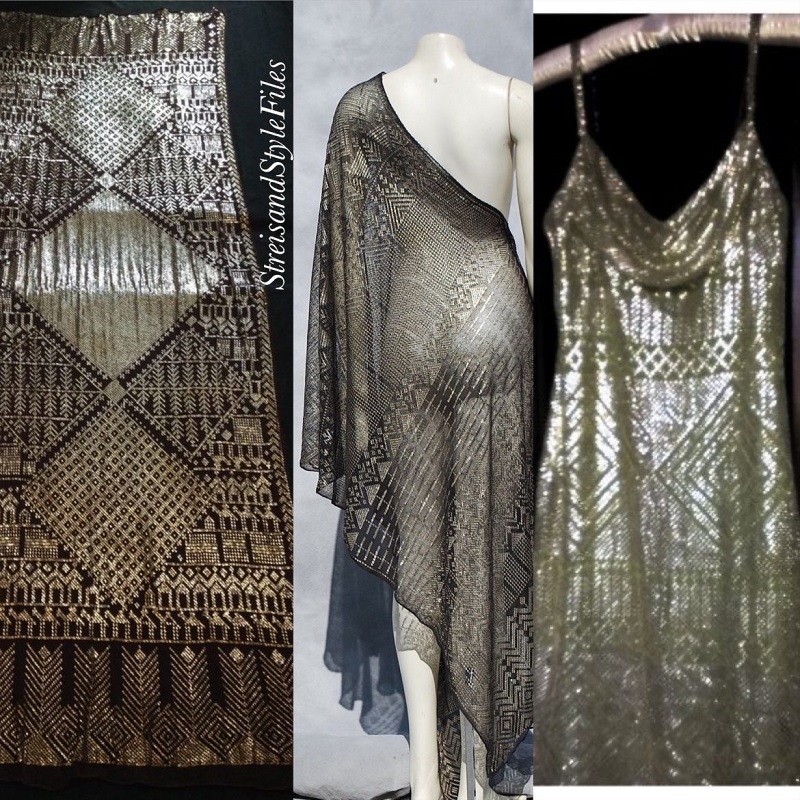 Tulle bi talli
Tulle bi talli
Tallī: (Turkish: tel – wire, string), Gulf Arab – a woven braided trimming made with metal wire, threads and ribbons often sewn on detachable panels used as embellishments. Other – (Synonym: tulle_bi_talli
Tūlle_bi_tallī: (French: Tulle – a city in France where fine material for veil was first made; Turkish: tel – wire; Synonym: tariq; talli; badla; khus_dozi
Khus_dozi: (Persian: Khvosh – an Iranian province; dozi – needlework; Synonym: tariq; talli; tulle_bi_talli; badla), series of small metal knots made on a woven net ground as embellishment. The term is commonly used in Iran and parts of the Arabian Peninsula possibly because Khvosh was one of the centres for the craft. Khus_dozi: (Persian: Khvosh – an Iranian province; dozi – needlework; Synonym: tariq; talli; tulle_bi_talli; badla), series of small metal knots made on a woven net ground as embellishment. The term is commonly used in Iran and parts of the Arabian Peninsula possibly because Khvosh was one of the centres for the craft.
Tallī: (Turkish: tel – wire, string), Gulf Arab – a woven braided trimming made with metal wire, threads and ribbons often sewn on detachable panels used as embellishments. Other – (Synonym: tulle_bi_talli
Tūlle_bi_tallī: (French: Tulle – a city in France where fine material for veil was first made; Turkish: tel – wire; Synonym: tariq; talli; badla; khus_dozi
Khus_dozi: (Persian: Khvosh – an Iranian province; dozi – needlework; Synonym: tariq; talli; tulle_bi_talli; badla), series of small metal knots made on a woven net ground as embellishment. The term is commonly used in Iran and parts of the Arabian Peninsula possibly because Khvosh was one of the centres for the craft. Khus_dozi: (Persian: Khvosh – an Iranian province; dozi – needlework; Synonym: tariq; talli; tulle_bi_talli; badla), series of small metal knots made on a woven net ground as embellishment. The term is commonly used in Iran and parts of the Arabian Peninsula possibly because Khvosh was one of the centres for the craft.
Tallī: (Turkish: tel – wire, string), Gulf Arab – a woven braided trimming made with metal wire, threads and ribbons often sewn on detachable panels used as embellishments. Other – (Synonym: tulle_bi_talli
Tūlle_bi_tallī: (French: Tulle – a city in France where fine material for veil was first made; Turkish: tel – wire; Synonym: tariq; talli; badla; khus_dozi
Khus_dozi: (Persian: Khvosh – an Iranian province; dozi – needlework; Synonym: tariq; talli; tulle_bi_talli; badla), series of small metal knots made on a woven net ground as embellishment. The term is commonly used in Iran and parts of the Arabian Peninsula possibly because Khvosh was one of the centres for the craft. Khus_dozi: (Persian: Khvosh – an Iranian province; dozi – needlework; Synonym: tariq; talli; tulle_bi_talli; badla), series of small metal knots made on a woven net ground as embellishment. The term is commonly used in Iran and parts of the Arabian Peninsula possibly because Khvosh was one of the centres for the craft.
Tallī: (Turkish: tel – wire, string), Gulf Arab – a woven braided trimming made with metal wire, threads and ribbons often sewn on detachable panels used as embellishments. Other – (Synonym: tulle_bi_talli
Tūlle_bi_tallī: (French: Tulle – a city in France where fine material for veil was first made; Turkish: tel – wire; Synonym: tariq; talli; badla; khus_dozi
Khus_dozi: (Persian: Khvosh – an Iranian province; dozi – needlework; Synonym: tariq; talli; tulle_bi_talli; badla), series of small metal knots made on a woven net ground as embellishment. The term is commonly used in Iran and parts of the Arabian Peninsula possibly because Khvosh was one of the centres for the craft. Khus_dozi: (Persian: Khvosh – an Iranian province; dozi – needlework; Synonym: tariq; talli; tulle_bi_talli; badla), series of small metal knots made on a woven net ground as embellishment. The term is commonly used in Iran and parts of the Arabian Peninsula possibly because Khvosh was one of the centres for the craft.
Tallī: (Turkish: tel – wire, string), Gulf Arab – a woven braided trimming made with metal wire, threads and ribbons often sewn on detachable panels used as embellishments. Other – (Synonym: tulle_bi_talli
Tūlle_bi_tallī: (French: Tulle – a city in France where fine material for veil was first made; Turkish: tel – wire; Synonym: tariq; talli; badla; khus_dozi
Khus_dozi: (Persian: Khvosh – an Iranian province; dozi – needlework; Synonym: tariq; talli; tulle_bi_talli; badla), series of small metal knots made on a woven net ground as embellishment. The term is commonly used in Iran and parts of the Arabian Peninsula possibly because Khvosh was one of the centres for the craft. Khus_dozi: (Persian: Khvosh – an Iranian province; dozi – needlework; Synonym: tariq; talli; tulle_bi_talli; badla), series of small metal knots made on a woven net ground as embellishment. The term is commonly used in Iran and parts of the Arabian Peninsula possibly because Khvosh was one of the centres for the craft.
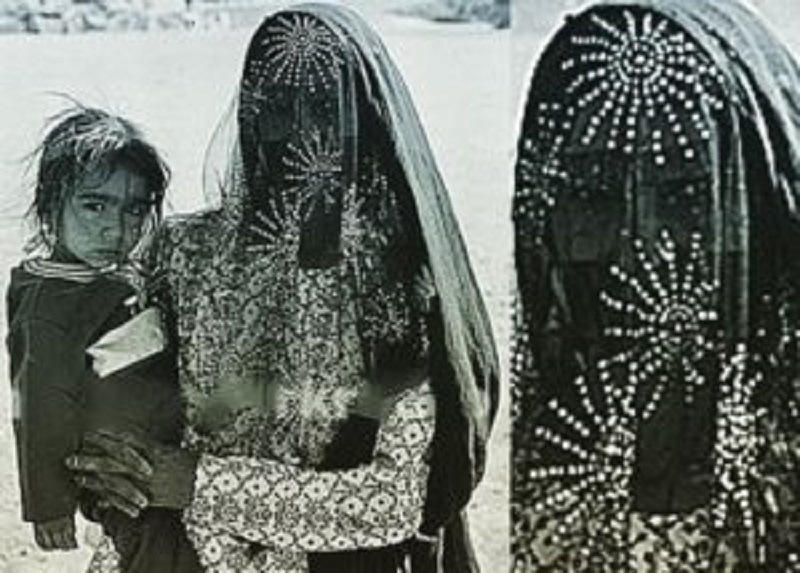 Stunning examples of mnaghad
Mnaghad: (Arabic: mnaqad: with coins, synonyms: mnaghadah
Mnaghadah: (Arabic: mnaqad: with coins). Since silver was a form of currency, it came to refer to silver adorned garments. The term refers to articles decorated with silver (tallī) straw (khūs) in small coin-like dots. In the Arab Gulf region, the terms (mnaghadah), (mnaghad) (nighdah) and (tallī) are often used interchangeably, with the (qāf) pronounced (gha) colloquially., naghdah
Naghdah: (Arabic: mnaqad: with coins, synonyms: mnaghadah
Mnaghadah: (Arabic: mnaqad: with coins). Since silver was a form of currency, it came to refer to silver adorned garments. The term refers to articles decorated with silver (tallī) straw (khūs) in small coin-like dots. In the Arab Gulf region, the terms (mnaghadah), (mnaghad) (nighdah) and (tallī) are often used interchangeably, with the (qāf) pronounced (gha) colloquially., mnaghad, mnaghadah
Mnaghadah: (Arabic: mnaqad: with coins). Since silver was a form of currency, it came to refer to silver adorned garments. The term refers to articles decorated with silver (tallī) straw (khūs) in small coin-like dots. In the Arab Gulf region, the terms (mnaghadah), (mnaghad) (nighdah) and (tallī) are often used interchangeably, with the (qāf) pronounced (gha) colloquially.). Since silver was a form of currency, it came to refer to silver adorned garments. The term refers to articles decorated with silver (tallī) straw (khūs) in small coin-like dots. The (qāf) is pronounced (gha) colloquially., mnaghadah
Mnaghadah: (Arabic: mnaqad: with coins). Since silver was a form of currency, it came to refer to silver adorned garments. The term refers to articles decorated with silver (tallī) straw (khūs) in small coin-like dots. In the Arab Gulf region, the terms (mnaghadah), (mnaghad) (nighdah) and (tallī) are often used interchangeably, with the (qāf) pronounced (gha) colloquially.). Since silver was a form of currency, it came to refer to silver adorned garments. The term refers to articles decorated with silver (tallī) straw (khūs) in small coin-like dots. The (qāf) is pronounced (gha) colloquially. decorated fabric used in everyday life. Khor Fakkan, 1975. Image from ‘A beginning of a nation’ and exhibition at the Empty Quarter featuring images by Anita van der Krol of Dubai in the late 1970s. 2014. Image credit: Anita van der Krol
Stunning examples of mnaghad
Mnaghad: (Arabic: mnaqad: with coins, synonyms: mnaghadah
Mnaghadah: (Arabic: mnaqad: with coins). Since silver was a form of currency, it came to refer to silver adorned garments. The term refers to articles decorated with silver (tallī) straw (khūs) in small coin-like dots. In the Arab Gulf region, the terms (mnaghadah), (mnaghad) (nighdah) and (tallī) are often used interchangeably, with the (qāf) pronounced (gha) colloquially., naghdah
Naghdah: (Arabic: mnaqad: with coins, synonyms: mnaghadah
Mnaghadah: (Arabic: mnaqad: with coins). Since silver was a form of currency, it came to refer to silver adorned garments. The term refers to articles decorated with silver (tallī) straw (khūs) in small coin-like dots. In the Arab Gulf region, the terms (mnaghadah), (mnaghad) (nighdah) and (tallī) are often used interchangeably, with the (qāf) pronounced (gha) colloquially., mnaghad, mnaghadah
Mnaghadah: (Arabic: mnaqad: with coins). Since silver was a form of currency, it came to refer to silver adorned garments. The term refers to articles decorated with silver (tallī) straw (khūs) in small coin-like dots. In the Arab Gulf region, the terms (mnaghadah), (mnaghad) (nighdah) and (tallī) are often used interchangeably, with the (qāf) pronounced (gha) colloquially.). Since silver was a form of currency, it came to refer to silver adorned garments. The term refers to articles decorated with silver (tallī) straw (khūs) in small coin-like dots. The (qāf) is pronounced (gha) colloquially., mnaghadah
Mnaghadah: (Arabic: mnaqad: with coins). Since silver was a form of currency, it came to refer to silver adorned garments. The term refers to articles decorated with silver (tallī) straw (khūs) in small coin-like dots. In the Arab Gulf region, the terms (mnaghadah), (mnaghad) (nighdah) and (tallī) are often used interchangeably, with the (qāf) pronounced (gha) colloquially.). Since silver was a form of currency, it came to refer to silver adorned garments. The term refers to articles decorated with silver (tallī) straw (khūs) in small coin-like dots. The (qāf) is pronounced (gha) colloquially. decorated fabric used in everyday life. Khor Fakkan, 1975. Image from ‘A beginning of a nation’ and exhibition at the Empty Quarter featuring images by Anita van der Krol of Dubai in the late 1970s. 2014. Image credit: Anita van der Krol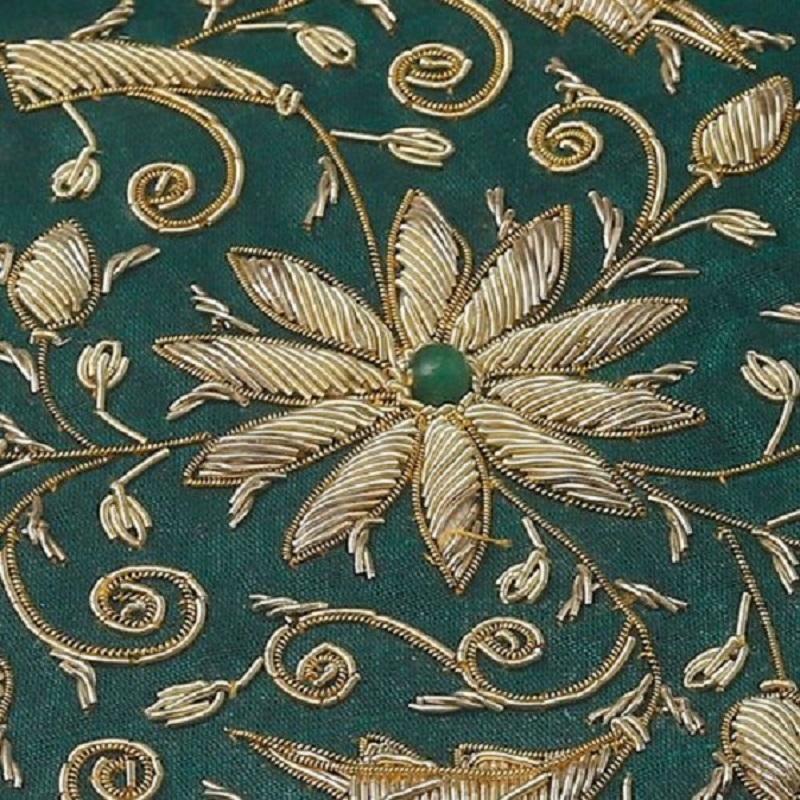 Zardozi
Zārdozī ( Persian: zar: gold, dozi: embellishment, synonyms: asūṭī, tallī,tur_bi_tallī/tulle_bi_talli, mnaqad/mnaghad,mukaish, badla/badlah, fardi, khus_dozi). Metallic thread embroidery. as it appeared in both India and Iran
Zardozi
Zārdozī ( Persian: zar: gold, dozi: embellishment, synonyms: asūṭī, tallī,tur_bi_tallī/tulle_bi_talli, mnaqad/mnaghad,mukaish, badla/badlah, fardi, khus_dozi). Metallic thread embroidery. as it appeared in both India and Iran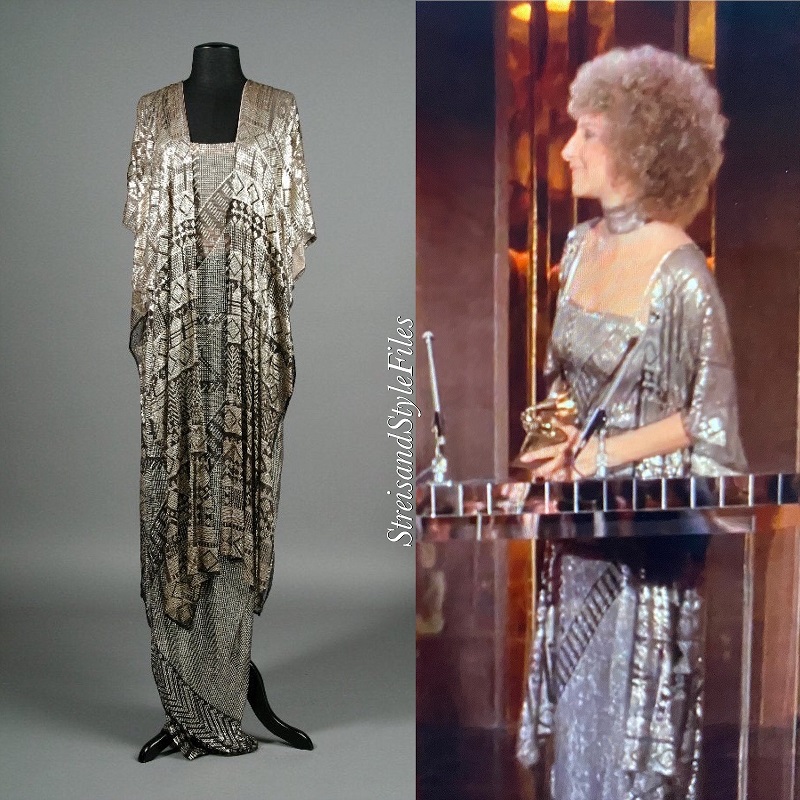 The iconic Tulle bi Talli
The iconic Tulle bi Talli
Tallī: (Turkish: tel – wire, string), Gulf Arab – a woven braided trimming made with metal wire, threads and ribbons often sewn on detachable panels used as embellishments. Other – (Synonym: tulle_bi_talli
Tūlle_bi_tallī: (French: Tulle – a city in France where fine material for veil was first made; Turkish: tel – wire; Synonym: tariq; talli; badla; khus_dozi
Khus_dozi: (Persian: Khvosh – an Iranian province; dozi – needlework; Synonym: tariq; talli; tulle_bi_talli; badla), series of small metal knots made on a woven net ground as embellishment. The term is commonly used in Iran and parts of the Arabian Peninsula possibly because Khvosh was one of the centres for the craft. Khus_dozi: (Persian: Khvosh – an Iranian province; dozi – needlework; Synonym: tariq; talli; tulle_bi_talli; badla), series of small metal knots made on a woven net ground as embellishment. The term is commonly used in Iran and parts of the Arabian Peninsula possibly because Khvosh was one of the centres for the craft.
Tallī: (Turkish: tel – wire, string), Gulf Arab – a woven braided trimming made with metal wire, threads and ribbons often sewn on detachable panels used as embellishments. Other – (Synonym: tulle_bi_talli
Tūlle_bi_tallī: (French: Tulle – a city in France where fine material for veil was first made; Turkish: tel – wire; Synonym: tariq; talli; badla; khus_dozi
Khus_dozi: (Persian: Khvosh – an Iranian province; dozi – needlework; Synonym: tariq; talli; tulle_bi_talli; badla), series of small metal knots made on a woven net ground as embellishment. The term is commonly used in Iran and parts of the Arabian Peninsula possibly because Khvosh was one of the centres for the craft. Khus_dozi: (Persian: Khvosh – an Iranian province; dozi – needlework; Synonym: tariq; talli; tulle_bi_talli; badla), series of small metal knots made on a woven net ground as embellishment. The term is commonly used in Iran and parts of the Arabian Peninsula possibly because Khvosh was one of the centres for the craft.
Tallī: (Turkish: tel – wire, string), Gulf Arab – a woven braided trimming made with metal wire, threads and ribbons often sewn on detachable panels used as embellishments. Other – (Synonym: tulle_bi_talli
Tūlle_bi_tallī: (French: Tulle – a city in France where fine material for veil was first made; Turkish: tel – wire; Synonym: tariq; talli; badla; khus_dozi
Khus_dozi: (Persian: Khvosh – an Iranian province; dozi – needlework; Synonym: tariq; talli; tulle_bi_talli; badla), series of small metal knots made on a woven net ground as embellishment. The term is commonly used in Iran and parts of the Arabian Peninsula possibly because Khvosh was one of the centres for the craft. Khus_dozi: (Persian: Khvosh – an Iranian province; dozi – needlework; Synonym: tariq; talli; tulle_bi_talli; badla), series of small metal knots made on a woven net ground as embellishment. The term is commonly used in Iran and parts of the Arabian Peninsula possibly because Khvosh was one of the centres for the craft.
Tallī: (Turkish: tel – wire, string), Gulf Arab – a woven braided trimming made with metal wire, threads and ribbons often sewn on detachable panels used as embellishments. Other – (Synonym: tulle_bi_talli
Tūlle_bi_tallī: (French: Tulle – a city in France where fine material for veil was first made; Turkish: tel – wire; Synonym: tariq; talli; badla; khus_dozi
Khus_dozi: (Persian: Khvosh – an Iranian province; dozi – needlework; Synonym: tariq; talli; tulle_bi_talli; badla), series of small metal knots made on a woven net ground as embellishment. The term is commonly used in Iran and parts of the Arabian Peninsula possibly because Khvosh was one of the centres for the craft. Khus_dozi: (Persian: Khvosh – an Iranian province; dozi – needlework; Synonym: tariq; talli; tulle_bi_talli; badla), series of small metal knots made on a woven net ground as embellishment. The term is commonly used in Iran and parts of the Arabian Peninsula possibly because Khvosh was one of the centres for the craft.
Tallī: (Turkish: tel – wire, string), Gulf Arab – a woven braided trimming made with metal wire, threads and ribbons often sewn on detachable panels used as embellishments. Other – (Synonym: tulle_bi_talli
Tūlle_bi_tallī: (French: Tulle – a city in France where fine material for veil was first made; Turkish: tel – wire; Synonym: tariq; talli; badla; khus_dozi
Khus_dozi: (Persian: Khvosh – an Iranian province; dozi – needlework; Synonym: tariq; talli; tulle_bi_talli; badla), series of small metal knots made on a woven net ground as embellishment. The term is commonly used in Iran and parts of the Arabian Peninsula possibly because Khvosh was one of the centres for the craft. Khus_dozi: (Persian: Khvosh – an Iranian province; dozi – needlework; Synonym: tariq; talli; tulle_bi_talli; badla), series of small metal knots made on a woven net ground as embellishment. The term is commonly used in Iran and parts of the Arabian Peninsula possibly because Khvosh was one of the centres for the craft.
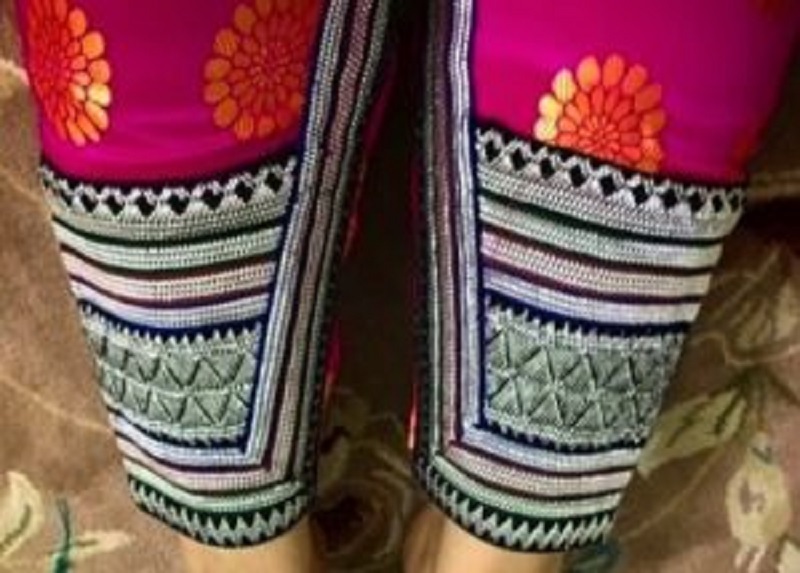 Talli
Talli
Tallī: (Turkish: tel – wire, string), Gulf Arab – a woven braided trimming made with metal wire, threads and ribbons often sewn on detachable panels used as embellishments. Other – (Synonym: tulle_bi_talli
Tūlle_bi_tallī: (French: Tulle – a city in France where fine material for veil was first made; Turkish: tel – wire; Synonym: tariq; talli; badla; khus_dozi
Khus_dozi: (Persian: Khvosh – an Iranian province; dozi – needlework; Synonym: tariq; talli; tulle_bi_talli; badla), series of small metal knots made on a woven net ground as embellishment. The term is commonly used in Iran and parts of the Arabian Peninsula possibly because Khvosh was one of the centres for the craft. Khus_dozi: (Persian: Khvosh – an Iranian province; dozi – needlework; Synonym: tariq; talli; tulle_bi_talli; badla), series of small metal knots made on a woven net ground as embellishment. The term is commonly used in Iran and parts of the Arabian Peninsula possibly because Khvosh was one of the centres for the craft.
Bādlah: (Hindustani: badal – cloud from Sanskirt: vārdala – water; Synonym: tariq; talli
Tallī: (Turkish: tel – wire, string), Gulf Arab – a woven braided trimming made with metal wire, threads and ribbons often sewn on detachable panels used as embellishments. Other – (Synonym: tulle_bi_talli
Tūlle_bi_tallī: (French: Tulle – a city in France where fine material for veil was first made; Turkish: tel – wire; Synonym: tariq; talli; badla; khus_dozi
Khus_dozi: (Persian: Khvosh – an Iranian province; dozi – needlework; Synonym: tariq; talli; tulle_bi_talli; badla), series of small metal knots made on a woven net ground as embellishment. The term is commonly used in Iran and parts of the Arabian Peninsula possibly because Khvosh was one of the centres for the craft. Khus_dozi: (Persian: Khvosh – an Iranian province; dozi – needlework; Synonym: tariq; talli; tulle_bi_talli; badla), series of small metal knots made on a woven net ground as embellishment. The term is commonly used in Iran and parts of the Arabian Peninsula possibly because Khvosh was one of the centres for the craft. Tūlle_bi_tallī: (French: Tulle – a city in France where fine material for veil was first made; Turkish: tel – wire; Synonym: tariq; talli; badla; khus_dozi
Khus_dozi: (Persian: Khvosh – an Iranian province; dozi – needlework; Synonym: tariq; talli; tulle_bi_talli; badla), series of small metal knots made on a woven net ground as embellishment. The term is commonly used in Iran and parts of the Arabian Peninsula possibly because Khvosh was one of the centres for the craft. Khus_dozi: (Persian: Khvosh – an Iranian province; dozi – needlework; Synonym: tariq; talli; tulle_bi_talli; badla), series of small metal knots made on a woven net ground as embellishment. The term is commonly used in Iran and parts of the Arabian Peninsula possibly because Khvosh was one of the centres for the craft.
Salwar: (Farsi: shalvār; Synonym: ṣarwāl, shirwāl ), trousers featuring tapering ankles and drawstring closure of Central Asian origin. They disseminated in the Indian subcontinent between c.1st-3rd century BCE. Although exact period of its arrival in the Arab world is disputed their widespread adoption is confirmed from the 12th century.
, Ṣarwāl, sharwāl, salbāl, khalag), pair of trousers with tapering ankles and fastened with a draw string. Believed to have originated in Central Asia it has spread since in the Indian subcontinent between c. 1st – 3rd century BCE and the Middle East from c. 12th century. from the UAETallī: (Turkish: tel – wire, string), Gulf Arab – a woven braided trimming made with metal wire, threads and ribbons often sewn on detachable panels used as embellishments. Other – (Synonym: tulle_bi_talli
Tūlle_bi_tallī: (French: Tulle – a city in France where fine material for veil was first made; Turkish: tel – wire; Synonym: tariq; talli; badla; khus_dozi
Khus_dozi: (Persian: Khvosh – an Iranian province; dozi – needlework; Synonym: tariq; talli; tulle_bi_talli; badla), series of small metal knots made on a woven net ground as embellishment. The term is commonly used in Iran and parts of the Arabian Peninsula possibly because Khvosh was one of the centres for the craft. Khus_dozi: (Persian: Khvosh – an Iranian province; dozi – needlework; Synonym: tariq; talli; tulle_bi_talli; badla), series of small metal knots made on a woven net ground as embellishment. The term is commonly used in Iran and parts of the Arabian Peninsula possibly because Khvosh was one of the centres for the craft.
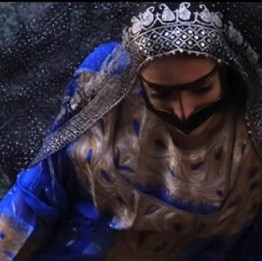
Tallī: (Turkish: tel – wire, string), Gulf Arab – a woven braided trimming made with metal wire, threads and ribbons often sewn on detachable panels used as embellishments. Other – (Synonym: tulle_bi_talli
Tūlle_bi_tallī: (French: Tulle – a city in France where fine material for veil was first made; Turkish: tel – wire; Synonym: tariq; talli; badla; khus_dozi
Khus_dozi: (Persian: Khvosh – an Iranian province; dozi – needlework; Synonym: tariq; talli; tulle_bi_talli; badla), series of small metal knots made on a woven net ground as embellishment. The term is commonly used in Iran and parts of the Arabian Peninsula possibly because Khvosh was one of the centres for the craft. Khus_dozi: (Persian: Khvosh – an Iranian province; dozi – needlework; Synonym: tariq; talli; tulle_bi_talli; badla), series of small metal knots made on a woven net ground as embellishment. The term is commonly used in Iran and parts of the Arabian Peninsula possibly because Khvosh was one of the centres for the craft.
Tallī: (Turkish: tel – wire, string), Gulf Arab – a woven braided trimming made with metal wire, threads and ribbons often sewn on detachable panels used as embellishments. Other – (Synonym: tulle_bi_talli
Tūlle_bi_tallī: (French: Tulle – a city in France where fine material for veil was first made; Turkish: tel – wire; Synonym: tariq; talli; badla; khus_dozi
Khus_dozi: (Persian: Khvosh – an Iranian province; dozi – needlework; Synonym: tariq; talli; tulle_bi_talli; badla), series of small metal knots made on a woven net ground as embellishment. The term is commonly used in Iran and parts of the Arabian Peninsula possibly because Khvosh was one of the centres for the craft. Khus_dozi: (Persian: Khvosh – an Iranian province; dozi – needlework; Synonym: tariq; talli; tulle_bi_talli; badla), series of small metal knots made on a woven net ground as embellishment. The term is commonly used in Iran and parts of the Arabian Peninsula possibly because Khvosh was one of the centres for the craft.
Tallī: (Turkish: tel – wire, string), Gulf Arab – a woven braided trimming made with metal wire, threads and ribbons often sewn on detachable panels used as embellishments. Other – (Synonym: tulle_bi_talli
Tūlle_bi_tallī: (French: Tulle – a city in France where fine material for veil was first made; Turkish: tel – wire; Synonym: tariq; talli; badla; khus_dozi
Khus_dozi: (Persian: Khvosh – an Iranian province; dozi – needlework; Synonym: tariq; talli; tulle_bi_talli; badla), series of small metal knots made on a woven net ground as embellishment. The term is commonly used in Iran and parts of the Arabian Peninsula possibly because Khvosh was one of the centres for the craft. Khus_dozi: (Persian: Khvosh – an Iranian province; dozi – needlework; Synonym: tariq; talli; tulle_bi_talli; badla), series of small metal knots made on a woven net ground as embellishment. The term is commonly used in Iran and parts of the Arabian Peninsula possibly because Khvosh was one of the centres for the craft.
Tallī: (Turkish: tel – wire, string), Gulf Arab – a woven braided trimming made with metal wire, threads and ribbons often sewn on detachable panels used as embellishments. Other – (Synonym: tulle_bi_talli
Tūlle_bi_tallī: (French: Tulle – a city in France where fine material for veil was first made; Turkish: tel – wire; Synonym: tariq; talli; badla; khus_dozi
Khus_dozi: (Persian: Khvosh – an Iranian province; dozi – needlework; Synonym: tariq; talli; tulle_bi_talli; badla), series of small metal knots made on a woven net ground as embellishment. The term is commonly used in Iran and parts of the Arabian Peninsula possibly because Khvosh was one of the centres for the craft. Khus_dozi: (Persian: Khvosh – an Iranian province; dozi – needlework; Synonym: tariq; talli; tulle_bi_talli; badla), series of small metal knots made on a woven net ground as embellishment. The term is commonly used in Iran and parts of the Arabian Peninsula possibly because Khvosh was one of the centres for the craft.